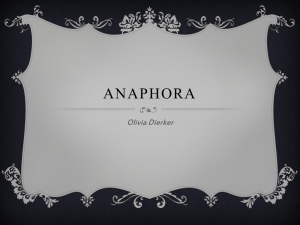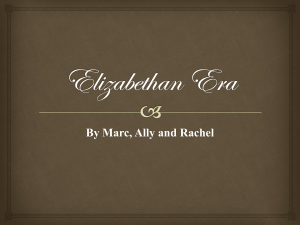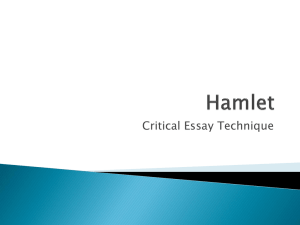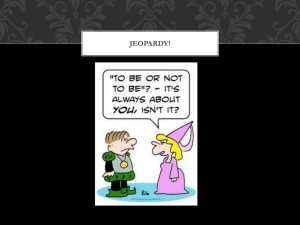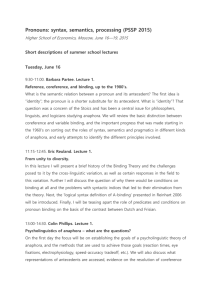Commentary Review & Examples
advertisement
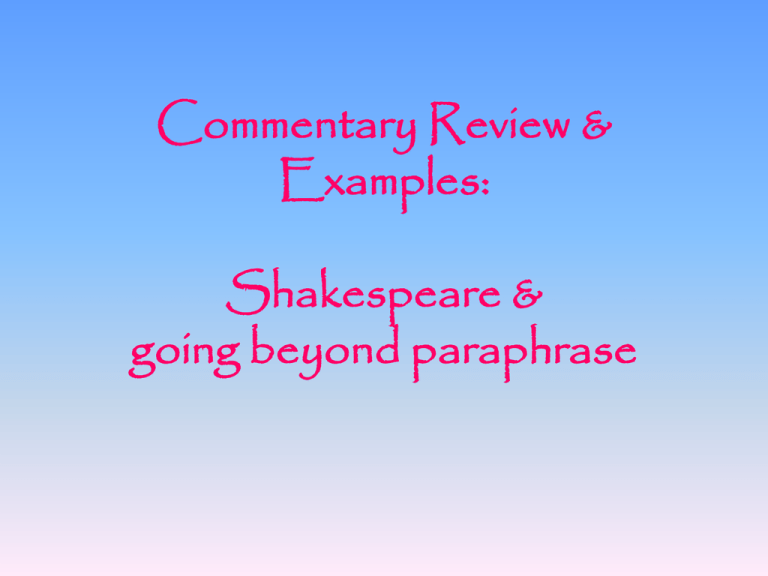
Commentary Review & Examples: Shakespeare & going beyond paraphrase What IB says makes a good commentary… “A good commentary integrates understanding with creativity of response and an awareness of how language suggests meaning. It appreciates how the parts contribute to the whole, and develops a comprehensive, systematic, and persuasive elucidation…” Look to how Shakespeare uses language and rhetorical devices to create an effect and promote a deeper meaning (which could be related to characters, themes, symbols, the Elizabethan Audience, etc…) Paraphrase = to rephrase and simplify -to restate something using other words, especially in order to make it simpler or shorter Analyze = 1. Study something closely: to examine something in great detail in order to understand it better or discover more about it; 2. Break something down into components: to find out what something is made up of by identifying its constituent parts 3. Examine structure: to study the structure of something or how its constituent parts are put together From quotation to paraphrase to deep analysis… Quotation: Thus was I, sleeping, by a brother’s hand, Of life, of crown, of queen, at once dispatched; Cut off even in the blossom of my sin, Unhouseled, disappointed, unaneled; No reckoning made, but sent to my account With all my imperfections on my head— Oh horrible, oh horrible, most horrible! Paraphrase: My own brother killed me while sleeping, taking my not only my life, but my power and wife. Even worse this occurred before I was issued my dying sacraments: communion, confession, and priest’s blessings; thus I have been damned. How horrible! Woe is me! Literary features present: Parenthesis, anaphora, parallel structure, repetition, cacophony overstatement, imagery, alliteration, caesura, ethos & pathos The ghost speaks, continued… Level 3 analysis When describing his murder, the late king Hamlet uses anaphora to emphasize the painful fact that his own bother took not just his life, but his power and his wife. Level 4 analysis When describing his murder, the late king Hamlet uses anaphora, “Of life, of crown, of queen” to emphasize the painful fact that his own brother took not just his life, but his power and his wife. Followed by another triad, “Unhouseled, disappointed, unaneled,” this fact is further highlighted by the damning effects of a Catholic who has been killed before repentance. Level 5 Analysis: When describing his murder, the late king Hamlet uses anaphora, “Of life, of crown, of queen” to emphasize the painful fact that his own bother took not just his life, but his power and his wife. Followed by another triad, “Unhouseled, disappointed, unaneled,” this murder is further highlighted by the damning effects of a Catholic who has been killed before repentance with three strong, negative verb forms sitting alone on one line. The use of caesura also slows this portion of the monologue, allowing the audience to feel the ghost’s deep pain. Here, pathos is the natural reaction of the crowd, as this murder goes against the church, family structures, and importance of royalty (and the laws against treason) engrained in Elizabethan life, especially as he exclaims three times, “oh horrible!” However, one is also forced to question King Hamlet’s ethos, as we are forced to consider his character—how many “imperfections” did he have “on [his] head” and just how “blossoming” was his sin… Turning central ideas into themes: What’s Shakespeare’s MESSAGE about… Central ideas: 1. Uncertainty 2. Frailty of women Ideas evolved into themes: 1. When one cannot even trust those closest to him, be it family or lover, he can never be sane and will eventually become as corrupt as those around him. 2. In a patriarchal society, women suffer a loss of power and often become the pawns of men. While today’s audiences might scoff at their stupidity, Elizabethan audiences would understand and support these diminished roles. Commentary Basics… • Context! • Thesis (umbrella idea) = unity & cohesion • Systematic discussion of key features (describe, analyze, reflect on the effect) – DAR • Conclusion: – How does this advance the plot of the play – What’s Shakespeare’s broader message (so what?)
